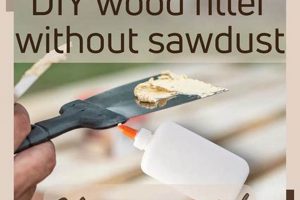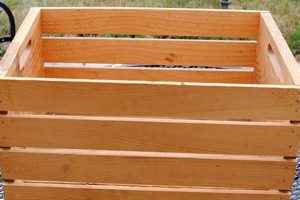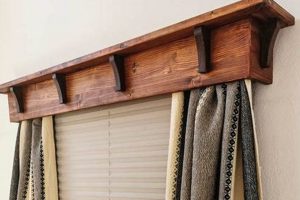Crafting customized light holders from timber enables individuals to create unique decorative items. This approach allows for a high degree of personalization in home dcor, reflecting specific aesthetic preferences. For instance, the dimensions, style, and finish can be tailored to complement existing interior design elements.
The practice of constructing bespoke light holders from wood offers several advantages, including cost savings compared to purchasing commercially produced items. It provides an opportunity to repurpose scrap materials, fostering sustainable practices. Historically, handcrafted light holders were commonplace, demonstrating resourcefulness and artisanal skill. Their enduring appeal lies in their blend of functionality and artistic expression.
The subsequent sections will delve into the tools, techniques, and design considerations involved in producing these handcrafted wooden items. Focus will be placed on ensuring safety, achieving desired aesthetic outcomes, and exploring various finishing methods.
Essential Considerations for Wooden Candlestick Construction
The following guidelines provide critical insights for the successful creation of wooden candlestick holders. Adherence to these recommendations will enhance both the aesthetic quality and structural integrity of the finished pieces.
Tip 1: Material Selection: Choose hardwoods such as maple, oak, or walnut for enhanced durability and stability. Softwoods like pine are acceptable, but require careful handling and finishing to prevent damage.
Tip 2: Precision Measurement: Accurately measure and mark all dimensions prior to cutting or shaping the wood. This ensures symmetrical proportions and consistent design execution.
Tip 3: Safe Tool Operation: Employ appropriate safety equipment, including eye protection and dust masks, when operating power tools such as lathes, saws, and drills. Secure the workpiece firmly to prevent slippage.
Tip 4: Pilot Hole Drilling: Always drill pilot holes before inserting screws to prevent splitting the wood. Select drill bit sizes that are slightly smaller than the screw diameter.
Tip 5: Gradual Shaping: When using a lathe, shape the wood gradually in small increments. This minimizes the risk of errors and allows for finer control over the final form.
Tip 6: Surface Preparation: Thoroughly sand all surfaces with progressively finer grits of sandpaper to achieve a smooth, uniform finish. Remove all dust before applying any finishes.
Tip 7: Finish Application: Apply finishes, such as stain, paint, or varnish, in thin, even coats. Allow each coat to dry completely before applying the next. Consider the compatibility of different finishes when layering.
Tip 8: Candle Safety: Ensure the finished candlestick holder is stable and can securely hold the intended candle size. Consider adding a metal insert to protect the wood from heat.
By focusing on material quality, accurate execution, and safe practices, the creation of high-quality wooden candlesticks can be achieved. The resulting pieces offer both functional utility and artistic value.
The subsequent sections will provide detailed instructions on specific construction techniques and design variations to further refine the process.
1. Material Selection
Material selection is a foundational element in the construction of wooden candlestick holders. The choice of wood species directly influences the durability, aesthetic qualities, and overall longevity of the finished product. A considered approach to material procurement is, therefore, paramount.
- Hardwood Durability
Hardwoods, such as maple, oak, and cherry, possess a dense cellular structure that imparts significant resistance to wear and tear. This inherent strength makes them suitable for candlestick holders intended for frequent use or display. The increased density also provides a more stable base, reducing the risk of tipping or instability.
- Softwood Considerations
Softwoods, including pine and fir, offer an alternative but present certain limitations. Their lower density makes them more susceptible to dents and scratches. However, softwoods can be viable options if carefully finished and treated to enhance their durability. Their lighter weight may also be advantageous in certain design applications.
- Grain Pattern Aesthetics
The grain pattern of the wood significantly contributes to the visual appeal of the candlestick holder. Different wood species exhibit distinct grain patterns, ranging from the subtle figuring of maple to the bold, pronounced grain of oak. Selection should align with the desired aesthetic, considering the intended style and dcor of the space where the candlestick will be displayed.
- Sustainability and Sourcing
Sustainable sourcing practices are increasingly important in woodworking. Opting for wood that is certified by organizations such as the Forest Stewardship Council (FSC) ensures responsible forest management and minimizes environmental impact. Consideration should also be given to using reclaimed or salvaged wood, which offers a unique character and reduces the demand for newly harvested timber.
The careful assessment of these factorsdurability, softwood limitations, grain aesthetics, and sustainable sourcingallows for informed material choices that directly impact the quality and longevity of wooden candlestick holders. The selected material should not only meet functional requirements but also complement the overall design and intended use of the finished piece.
2. Design Conceptualization
Design conceptualization serves as the initial phase in creating wooden candlestick holders, providing a framework for translating ideas into tangible forms. Its significance lies in determining the aesthetic, functional, and structural parameters of the project. A well-defined concept ensures that the finished product aligns with the intended purpose and desired visual characteristics.
- Form and Proportion
The shape and dimensions of the candlestick holder are fundamental design considerations. Form dictates the overall silhouette, ranging from simple cylindrical shapes to more complex geometric designs. Proportion refers to the relationship between different parts, ensuring visual harmony and stability. For instance, a candlestick with an excessively tall stem relative to its base may be unstable. Considerations must include candle size, intended visual balance and safety for the candle chosen.
- Style and Aesthetic
The style of the candlestick holder should complement the surrounding decor and reflect the individual’s aesthetic preferences. Styles can range from traditional, incorporating ornate carvings and classical motifs, to modern, emphasizing clean lines and minimalist forms. Rustic designs may feature natural textures and distressed finishes. The chosen style dictates the materials, techniques, and finishing methods employed.
- Functionality and Ergonomics
Beyond aesthetics, functionality is a crucial design element. The candlestick holder must securely hold a candle of a specific size and prevent it from tipping over. Ergonomic considerations include ease of handling and cleaning. The design may incorporate features such as a wide base for stability or a metal insert to protect the wood from heat. Considerations for air flow to maintain candle burning are also a key consideration.
- Material Integration and Feasibility
The design concept must account for the properties and limitations of wood. The chosen design should be feasible to execute using available woodworking tools and techniques. The design may leverage the natural grain patterns of the wood to enhance visual interest. The design is often modified as skill and the specific project progresses.
These facets of design conceptualization inform the subsequent stages of construction, ensuring that the resulting wooden candlestick holder is not only visually appealing but also functional, durable, and safe. The interplay between these considerations ultimately determines the success of the project, transforming a simple idea into a tangible and aesthetically pleasing object.
3. Turning Techniques
The creation of custom light holders frequently relies on turning techniques, a manufacturing process crucial for achieving symmetrical, aesthetically pleasing forms. The rotational shaping of wood on a lathe allows for intricate detailing and consistent dimensions not readily attainable through other methods. A skilled application of turning techniques directly correlates with the final visual appeal and structural integrity of the finished product. In instances of creating tapered candlestick designs, the lathe is indispensable for forming the smooth, continuous curves that define the shape. Similarly, decorative elements such as beads, coves, and flutes are accurately and efficiently produced through the manipulation of cutting tools on a rotating workpiece. Without proficiency in these techniques, the resulting wooden candlesticks may exhibit irregularities in shape and surface finish.
Further significance is observed in the efficient production of multiple, identical light holders. Turning techniques facilitate the creation of templates and jigs, enabling the replication of complex designs with minimal variation. This consistency is particularly important when crafting sets of candlesticks for formal settings or commercial purposes. Additionally, advanced turning techniques, such as segmented turning and hollow form turning, expand the design possibilities, enabling the creation of visually striking and structurally complex pieces. For instance, segmented turning allows the combination of different wood species, creating patterns and textures that would be impossible to achieve with a single piece of wood. Hollow form turning allows the creation of complex inner shapes that add unique value to final outcome.
In summary, the effective application of turning techniques is a critical determinant of the quality, aesthetic appeal, and replicability of do-it-yourself wooden candlesticks. Mastery of these techniques empowers the craftsman to translate design concepts into tangible objects with precision and efficiency. While alternative construction methods exist, none offer the same degree of control and versatility in shaping wood for this specific application. Therefore, familiarity with turning techniques represents a fundamental skill for those pursuing the creation of high-quality wooden light holders.
4. Surface Finishing
Surface finishing constitutes a critical stage in the creation of wooden candlestick holders, directly influencing both aesthetic appeal and long-term durability. The application of appropriate finishing techniques protects the underlying wood from environmental factors, such as moisture and ultraviolet radiation, thereby extending the lifespan of the piece. Unfinished wood is susceptible to warping, cracking, and discoloration, diminishing its aesthetic value and structural integrity. For example, a candlestick holder left untreated in a humid environment may develop mold or mildew, while exposure to sunlight can cause fading and discoloration. The choice of finish, whether it be paint, stain, varnish, or oil, determines the final appearance of the piece and contributes to its overall aesthetic character.
The practical significance of surface finishing extends beyond mere aesthetics. A well-applied finish creates a barrier against potential damage from spills, scratches, and other forms of wear and tear. This protection is particularly important for candlestick holders, which are frequently exposed to wax drippings and handling. Furthermore, certain finishes, such as fire-retardant coatings, can enhance the safety of the candlestick holder by reducing the risk of ignition from errant flames. For instance, the application of a polyurethane varnish creates a hard, durable surface that is resistant to water damage and scratches, while also providing a glossy finish that enhances the wood’s natural grain patterns. Conversely, the use of an oil finish, such as linseed oil, penetrates the wood fibers, nourishing and protecting them from within, while imparting a natural, matte appearance.
In summary, surface finishing is an indispensable component of crafting wooden candlestick holders, offering both aesthetic enhancement and crucial protection against environmental factors and physical wear. The careful selection and application of appropriate finishing techniques are essential for ensuring the longevity, beauty, and safety of the finished product. Challenges may arise in achieving a uniform finish or selecting the optimal product for a specific wood type, but the benefits of proper surface finishing far outweigh these difficulties, contributing significantly to the overall quality and value of the handcrafted item.
5. Safety Protocols
Adherence to safety protocols is paramount in the fabrication of wooden candlestick holders. The utilization of power tools, flammable materials, and open flames inherently presents risks that necessitate strict adherence to safety guidelines. Failure to implement appropriate safety measures can result in physical injury, property damage, or even fire. For example, improper use of a lathe can cause severe lacerations or fractures, while inadequate ventilation during the application of solvent-based finishes can lead to respiratory distress or explosion. Therefore, a comprehensive understanding and rigorous application of safety protocols constitute an indispensable component of the entire creation process.
Practical application of safety protocols encompasses several key areas. Eye protection is crucial to prevent wood particles or debris from causing injury. Respiratory protection, such as a dust mask or respirator, mitigates the inhalation of harmful substances generated during sanding, cutting, and finishing. Safe handling of cutting tools, including sharp chisels and saws, minimizes the risk of cuts and abrasions. A well-ventilated workspace prevents the accumulation of flammable vapors, reducing the potential for fire hazards. Stable work surfaces and secure clamping mechanisms ensure the workpiece remains firmly in place, preventing accidents during turning or shaping operations. Furthermore, it is critical to maintain a clean and organized work area to minimize trip hazards and ensure clear access to tools and materials.
In summary, safety protocols are not merely an ancillary consideration but rather a fundamental and integral element in the construction of wooden candlestick holders. A proactive approach to safety mitigates potential hazards, protects the craftsman from injury, and ensures the creation of a safe and reliable finished product. Challenges may arise in maintaining vigilance and consistently adhering to safety guidelines, but the consequences of neglecting these protocols far outweigh the perceived inconvenience. By prioritizing safety, the creation of wooden candlestick holders becomes a rewarding and responsible endeavor.
6. Candle Compatibility
Candle compatibility is a crucial consideration in the design and construction of homemade light holders. The dimensions and structural integrity of the wooden base must align with the intended candle type to ensure safety and prevent hazards.
- Diameter and Stability
The diameter of the candle-receiving recess or platform must correspond appropriately with the candle’s base. Insufficient diameter leads to instability, increasing the risk of tipping and wax spillage. For example, a thin taper candle placed in a holder designed for a larger pillar candle will be prone to falling over. Proper diameter ensures a secure fit and reduces the likelihood of accidents.
- Height and Center of Gravity
The height of the light holder relative to its base influences the overall center of gravity. Taller candlesticks require a wider and heavier base to maintain stability, especially when accommodating taller candles. A disproportionate design can result in a top-heavy structure, easily toppled by minor disturbances. Stability is particularly important to address, as falling candles can result in fire.
- Heat Resistance and Material Selection
Wood is inherently flammable, requiring careful attention to heat resistance. Metal inserts or coatings can mitigate the risk of ignition from prolonged exposure to a burning candle. Certain wood species, such as hardwoods, exhibit greater heat resistance compared to softwoods. Ensuring adequate distance between the flame and the wooden structure is paramount to prevent scorching or combustion.
- Candle Type and Intended Use
Different candle types necessitate specific design considerations. Taper candles require a narrow, tapered socket for secure placement, while pillar candles demand a flat, stable surface with sufficient diameter. Votive candles typically require a recessed holder to contain melted wax. The intended candle type dictates the overall design and dimensions of the light holder.
The successful integration of these facets ensures that handmade wooden candlesticks are not only aesthetically pleasing but also safe and functional. Neglecting compatibility can lead to hazardous situations, underscoring the need for meticulous planning and execution in the design phase.
Frequently Asked Questions
The following section addresses common inquiries regarding the design, construction, and safety aspects of creating handcrafted light holders from timber.
Question 1: What types of wood are most suitable for crafting light holders?
Hardwoods, such as maple, oak, and walnut, are recommended due to their density and durability. These species offer greater resistance to heat and physical damage compared to softwoods like pine or fir.
Question 2: Is it necessary to use a lathe for creating homemade wooden candlesticks?
While a lathe facilitates the creation of symmetrical, rounded forms, it is not strictly essential. Alternative methods, such as carving or assembling pre-cut pieces, can also be employed, depending on the desired design.
Question 3: What safety precautions should be observed when working with woodworking tools?
Eye protection, respiratory protection (dust mask or respirator), and appropriate work attire are essential. Ensure tools are sharp and in good working order. Secure the workpiece firmly and maintain a clean, well-lit workspace.
Question 4: How can one prevent wooden light holders from catching fire?
Employ metal inserts or coatings to shield the wood from direct flame exposure. Maintain a safe distance between the candle flame and the wooden structure. Consider using fire-retardant finishes.
Question 5: What type of finish is most appropriate for wooden candlesticks?
The choice of finish depends on the desired aesthetic and level of protection. Varnish provides a durable, glossy finish, while oil-based finishes offer a more natural, matte appearance. Ensure the finish is compatible with the chosen wood species and intended use.
Question 6: How does one ensure the stability of a light holder?
The base of the candlestick should be wider and heavier than the upper portion. Ensure the candle-receiving recess or platform is appropriately sized for the intended candle. Consider adding weight to the base for increased stability.
In summary, the successful creation of customized wooden light holders requires careful attention to material selection, safety protocols, and design considerations. Addressing these frequently asked questions contributes to a more informed and responsible crafting process.
The subsequent section will explore advanced techniques and design variations for further refinement of the process.
Conclusion
The preceding exploration of “diy wooden candlesticks” has underscored the importance of material selection, design conceptualization, safety adherence, and functional considerations. Successful execution demands proficiency in woodworking techniques and a thorough understanding of potential hazards associated with open flames. The discussed guidelines aim to provide a framework for creating safe and aesthetically pleasing items.
Continued refinement of skills and a commitment to responsible crafting practices will ensure the enduring value and safety of homemade light holders. By upholding rigorous standards in both design and construction, artisans can contribute to a legacy of craftsmanship that prioritizes both beauty and functionality. The pursuit of excellence in this craft remains a worthwhile endeavor.







